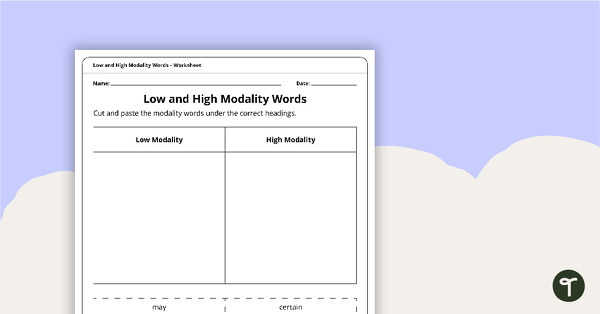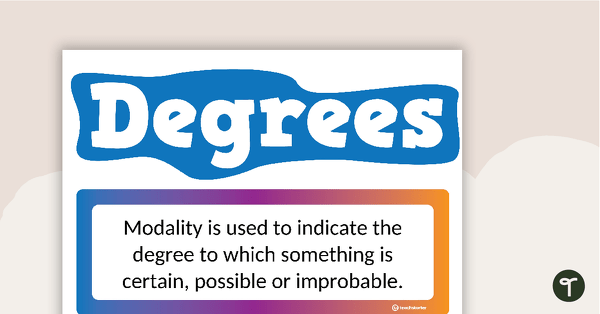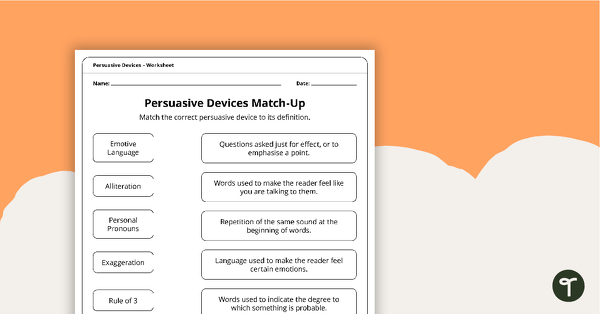Persuasive Devices Teaching Resources
Persuasive devices are vital to understand and use when writing persuasively. Some examples of persuasive devices are alliteration, rhetorical questions, exaggeration, statistics, emotive language, modality, repetition, facts, opinion, the rule of 3 and using personal pronouns. Use this collection of persuasive devices teaching resources when learning about each device and how to use it correctly. Resources available include lesson plans, vocabulary word walls, worksheets, posters and PowerPoint presentations.
- Plus Plan

Persuasive Techniques Posters
A set of 12 persuasive techniques posters with examples of different methods.
- Plus Plan

Low and High Modality Words – Worksheet
A sorting activity for low and high modality words.
- Plus Plan

Rhetorical Questions Worksheet
A worksheet to consolidate students' understanding of rhetorical questions.
- Plus Plan

Literature Study - Upper Primary - Task Cards
A set of 14 literature study task cards for upper primary students to use when analysing children's literature.
- Plus Plan

Literature Study - Lower Primary - Task Cards
A set of 12 literature study task cards for lower primary students to use when analysing children's literature.
- Plus Plan

Advertisement Worksheet – Milton Mentor
A comprehension worksheet for a persuasive magazine advertisement about a digital personal assistant.
- Plus Plan

Advertisement Worksheet – K-9ine the Robot Dog
A comprehension worksheet for a persuasive magazine advertisement about a robotic dog.
- Plus Plan

Personal Pronouns Worksheet
A worksheet to consolidate students' understanding of using personal pronouns in their persuasive writing.
- Plus Plan

Using Persuasive Language Worksheet – Living in a Treehouse
A worksheet to consolidate students' understanding of persuasive devices.
- Plus Plan

Modality Words Worksheet
A worksheet to consolidate students’ understanding of high modality and low modality words.
- Plus Plan

Finding Persuasive Devices Worksheet
A worksheet to consolidate students' understanding of persuasive devices.
- Plus Plan

Emotive Language Worksheet
A worksheet to consolidate students' understanding of emotive language.
- Plus Plan

Using Persuasive Language – A Turtle for a Pet
A worksheet that allows students to practice using persuasive devices in their writing.
- Plus Plan

Persuasive Writing Worksheet - Would You Rather?
A worksheet for students to use to write an persuasive composition.
- Plus Plan

Persuasive Language Devices Worksheet Pack
A set of 8 worksheets to help introduce persuasive language devices.
- Plus Plan

Persuasive Devices Sorting Activity
A hands-on sorting activity to use when introducing persuasive devices.
- Plus Plan

Introduction to Persuasive Devices PowerPoint
A 14 slide editable PowerPoint template to use when introducing your students to persuasive devices.
- Plus Plan

Identifying Persuasive Language Worksheets
A set of 3 worksheets to help your students identify the language features of persuasive texts.
- Plus Plan

Modality Word Wall with Information
A set of 56 vocabulary words based on the degrees of modality in persuasive writing.
- Plus Plan

Persuasive Devices PowerPoint
A 28 slide editable PowerPoint template to use when teaching your students about persuasive devices.
- Plus Plan

Persuasive Devices Worksheets
A set of 4 worksheets to use when teaching your students about persuasive devices.
- Plus Plan

Five Wonders Theme Park: Replace and Upgrade – Project
A project where students get to decide on a new ride they can design to put into Five Wonders Theme Park.
- Plus Plan

Using Persuasive Devices
A 60 minute lesson in which students will identify and explore persuasive devices.
- Plus Plan

Building an Opinion Using Persuasive Devices
A 60 minute lesson in which students will use persuasive devices to build a convincing opinion about an issue.
- Plus Plan

Introducing Persuasive Devices
A 60 minute lesson in which students will explore how persuasive devices can be used to strengthen a point of view.
-

28 Tips (and 10 Books!) for Teaching Persuasive Writing
By teaching persuasive writing effectively, we prepare our students not only for future learning, but for life in a world where opinions are everywhere.